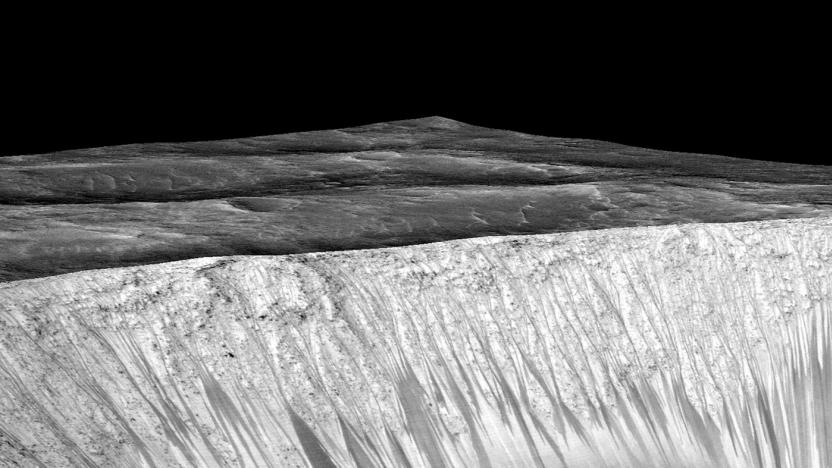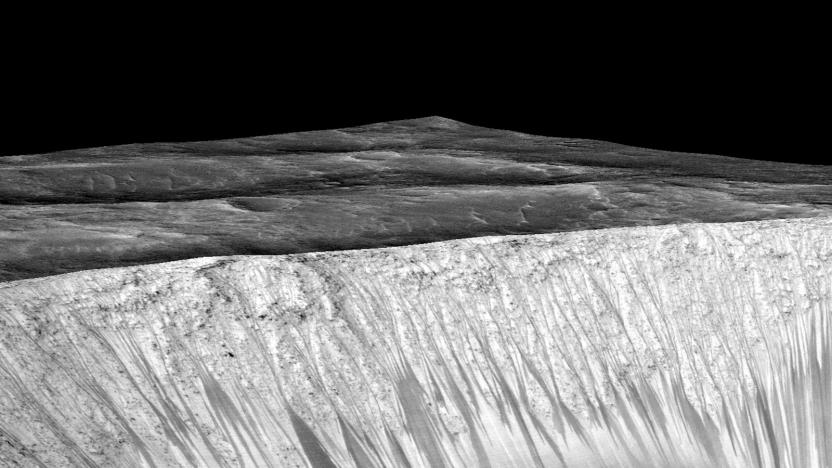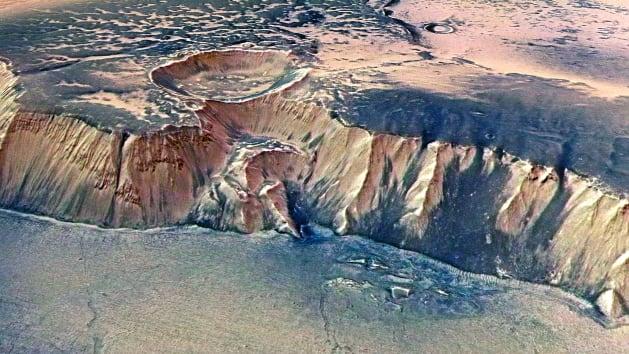TL16MRSAQUA
Latest

There may be water on Mars, but not much
Remember those weird dark streaks that NASA's Mars Reconnaissance Orbiter found last September? These recurring slope lineae (RSL), as they're called, were originally thought to contain liquid water. On Mars, liquid water would obviously be a huge deal because it means both potential source of life and potential resource. Well, it turns out that there isn't nearly as much water in those RSLs as astronomers had hoped and certainly none that's potable. What's more, new analysis has estimated that the amount of liquid surface water on Mars cannot exceed that of Earth's driest deserts.

Mars' veins were created by vanishing ancient lakes
Scientists just produced stronger evidence that Mars once had water lakes that might have nurtured life. After combing over Curiosity rover data, the researchers determined that veins in places like the planet's Gale Crater were likely created by evaporating lakes whose sediments were buried, heated and corroded. The discoveries also suggest that the water in these areas would have been habitable, if not exactly pleasant to drink -- it would have had about 20 times more sodium and sulphate than your bottled water back on Earth. There were likely "multiple generations" of water, NASA adds.

We might not be able to use Martian water after all
Remember those dark streaks NASA's Mars Reconnaissance Orbiter spotted running down canyons and hillsides on the red planet? They indicated the presence of water, which was a cause for celebration, as having water on Mars means astronauts won't have to carry as much when they visit. Unfortunately, a new study says the planet's water might not be drinkable. Worse, it might not even exist. A team of scientists from the University of Arizona looked more closely into those dark streaks called "recurrent slope linae" or RSL in an effort to figure out their origin.

Curiosity rover may sample Mars water
Scientists have already found hints of liquid water on Mars... now, they want to take a close look at it. NASA has revealed that the Curiosity rover will investigate recurring slope lineae (those streaks you see above) around Mars' Gale Crater in hopes of finding water. It'll first take a photo with its mast camera to verify that there's water in the first place. If there is, the machine will head over to collect samples. The agency would like to take those photos within a year, so you wouldn't have to wait too long to get answers.

Mars faced an ice age 400,000 years ago, and it's still recovering
We've known for a while now that Mars has water frozen in ice. And analyzing that water has been a key goal to understanding how the planet has changed over time, especially if its presence meant it once held life. Today, a newly published study concludes that Mars is ever-so slowly exiting an ice age that ended 400,000 years ago.

Ancient mega-tsunamis hint at cold Martian oceans
3.4 billion years ago, a meteorite smashed into the northern plains of Mars, where an ancient ocean once stood. Its impact threw up a massive wall of liquid water that scarred the surrounding landscape with backwash channels as the water poured back into the Martian sea. A few million years later, after the Red Planet had cooled significantly, another huge chunk of space rock tore into Mars -- however, this time, the resulting tsunami was made of ice blobs that simply stuck wherever they landed rather than return to the sea.

Scientists find signs of liquid water on the surface of Mars
Liquid water isn't just a thing of the past for Mars -- NASA just revealed that it's also present on the planet's surface today, the New York Times reports. Scientists have detected evidence of hydrated salts on the surface of Mars, which are produced by liquid water. That leads to the conclusion that liquid water is far more prevalent on Mars than we ever thought. Alfred S. McEwan, a University of Arizona professor of planetary geology, made the discovery along with other scientists after going over images from NASA's Mars Reconnaissance Orbiter. Back in 2011, they found dark streaks (dubbed "recurrent slope linae," or R.S.L.s) alongside canyons, slopes and craters on Mars, which lengthened and disappeared seasonally. Scientists figured water might have been involved with R.S.L.'s initially, but it wasn't confirmed until they pointed a spectrometer on the Martian surface and discovered the hydrated salts.

Mars once had enough water to form a large ocean
You probably know that Mars hasn't always been so barren, but have you wondered what it was like in its heyday? You almost wouldn't recognize it, according to an international team of scientists. They've used six years of atmospheric monitoring to determine that Mars had enough water to form a big but shallow (one mile deep) ocean that covered almost half of the northern hemisphere four billion years ago. The artist's rendition above gives you an idea of what it might have looked like -- the Red Planet would have been decidedly blue in places.

NASA: Mars' Gale Crater held a huge lake for millions of years
Humans have been speculating about water on Mars for hundreds of years, and now thanks to the Curiosity rover we're getting a better sense of how wet the Red Planet used to be. NASA revealed today that the Gale Crater, the 96-mile wide patch of land Curiosity has been exploring since 2012, held a large lake bed for tens of millions of years. What's more, the agency found that the three-mile high Mount Sharp, which sits in the middle of the crater, was likely formed by sediment deposits from the lake. The big takeaway? Mars was likely warm enough to house liquid water for long periods of time -- perhaps even long enough for life to form. "If our hypothesis for Mount Sharp holds up, it challenges the notion that warm and wet conditions were transient, local or only underground on Mars," said Ashwin Vasavada, NASA's Curiosity deputy project scientist. The only problem now is that we still don't know how the Martian atmosphere supported such a wet environment.

NASA's Curiosity finds two percent of Martian soil is composed of water
We already knew Mars was blanketed in ancient riverbeds, which points to the existence of water in the distant past. What we didn't know, however, is that H2O exists on Mars in the here and now -- albeit embedded in Martian soil. A paper recently published in the journal Science revealed that as much as two percent of dirt from the Red Planet contains the precious liquid. The Curiosity rover gathered samples of the sand from the "Rocknest" area near the Gale Crater back in August of 2012 and delivered it to the Sample Analysis at Mars (SAM) instrument inside its belly. After heating the sample to around 835 Celsius, SAM was able to detect a surprising amount of carbonate materials, which are formed in the presence of water. Laurie Leshin, dean of science at Rensselaer Polytechnic Institute and the study's lead author said the findings are conclusive: "If you took about a cubic foot of the dirt and heated it up, you'd get a couple of pints of water out of that -- a couple of water bottles' worth that you would take to the gym." Another SAM discovery is a mineral called perchlorate that could interfere with thyroid functions if ingested. Still, if we could work around that, the findings could prove tremendously useful for future Mars explorers. "When we send people," Leshin said in the paper, "they could scoop up the soil anywhere on the surface, heat it just a bit, and obtain water." We're likely years away from having fishing expeditions in Mars, of course, but this does soften the blow about the possible lack of life.

NASA's Curiosity rover finds ancient streambed on Mars, evidence of 'vigorous' water flow
Curiosity may have spent a while limbering up for the mission ahead, but now it's found evidence of an ancient streambed on Mars that once had "vigorous" water flow. Photos of two rock outcroppings taken by the rover's mast camera between the north rim of Gale Crater and the foot of Mount Sharp reveal gravel embedded into a layer of conglomerate rock. The shape of the small stones indicate to NASA JPL scientists that they were previously moved, and their size (think from grains of sand to golf balls) are a telltale sign that water did the work instead of wind. Evidence of H2O on Mars has been spotted before, but this is the first direct look at the composition of riverbeds NASA has observed from above. According to Curiosity science co-investigator William Dietrich, it's estimated that water flowed at the site anywhere from thousands to millions of years ago, moved at a clip of roughly 3 feet per second and was somewhere between ankle and hip deep. "A long-flowing stream can be a habitable environment," Mars Science Laboratory Project Scientist John Grotzinger said. "It is not our top choice as an environment for preservation of organics, though. We're still going to Mount Sharp, but this is insurance that we have already found our first potentially habitable environment."

NASA's solar-powered Juno mission heads to Jupiter today, Orbiter finds water on Mars? (video)
NASA's Juno mission has been beset by delays for a while now, but the solar-powered excursion is finally scheduled to take off for Jupiter today, in the hopes of making history. Throughout the course of its five-year journey, the "armored tank" spacecraft will be powered exclusively by a trio of solar panels, each measuring nine feet wide and 30 feet long. Close to Earth, these panels will be able to generate 14 kilowatts of electricity, but as Juno ventures deeper into space, they'll crank out only 400 watts. Power, however, shouldn't be an issue, as NASA has outfitted the craft with energy efficient onboard computers, and has drawn out a route that will maximize its exposure to the sun. Juno should arrive at Jupiter by 2016 and, if all goes to plan, will ultimately travel farther than any solar-powered craft ever has. The agency expects their creation to set the record in April 2017, when it should be about 507 million miles away from the sun, eclipsing the 492 million mile mark likely to be set by Russia's sun-juiced Rosetta craft, in 2012. Meanwhile, closer to home, the Mars Reconnaissance Orbiter has just delivered new imagery of the Red Planet's mountains, providing perhaps the strongest evidence that water still flows there. The images reveal long, finger-like tendrils that extend down steep slopes, including the rims of craters. They appear during the summer and fade away once winter arrives, suggesting the presence of a volatile material. Researchers failed to identify water above ground, but speculate that briny water may be flowing underground. Launch past the break to see the images, in all their eight seconds of glory.







